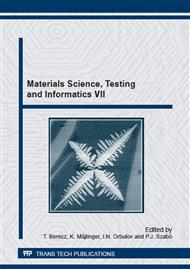p.351
p.357
p.363
p.369
p.375
p.381
p.387
p.393
p.399
The Properties of Welded Joints Made by 6082-T6 Aluminium Alloy and their Behaviour under Cyclic Loading Conditions
Abstract:
The magnitude of different aluminium alloys, especially the ones with higher strength, are increasing in the structural engineering, not just the usual applications (like the aerospace industry) but more likely in the automotive industry. There are more assumptions of the effective use of aluminium; we should highlight two important factors, the technological and the applicability criterions. The technological criterion is the joining of structural elements, frequently with welding thus the technological criterion ultimately is the weldability. The assumption of applicability comes from the loading capability of these structures, which is typically cyclic loading so the key issue from the point of view of applicability is the resistance to fatigue. This article represents physical simulation and fatigue test results both on the base material and on the welded joints.
Info:
Periodical:
Pages:
375-380
Citation:
Online since:
February 2015
Authors:
Price:
Сopyright:
© 2015 Trans Tech Publications Ltd. All Rights Reserved
Share:
Citation:


